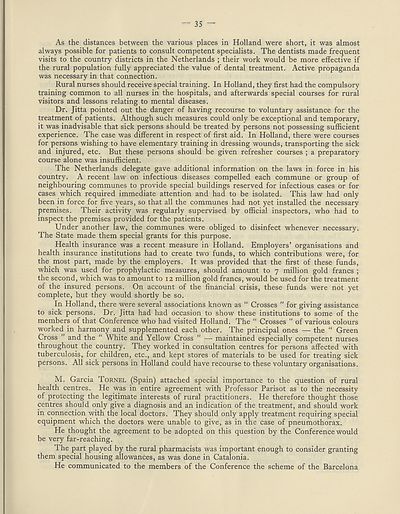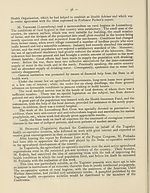Download files
Complete book:
Individual page:
Thumbnail gallery: Grid view | List view

— 35 —
As the distances between the various places in Holland were short, it was almost
always possible for patients to consult competent specialists. The dentists made frequent
visits to the country districts in the Netherlands ; their work would be more effective if
the rural population fully appreciated the value of dental treatment. Active propaganda
was necessary in that connection.
Rural nurses should receive special training. In Holland, they first had the compulsory
training common to all nurses in the hospitals, and afterwards special courses for rural
visitors and lessons relating to mental diseases.
Dr. Jitta pointed out the danger of having recourse to voluntary assistance for the
treatment of patients. Although such measures could only be exceptional and temporary,
it was inadvisable that sick persons should be treated by persons not possessing sufficient
experience. The case was different in respect of first aid. In Holland, there were courses
for persons wishing to have elementary training in dressing wounds, transporting the sick
and injured, etc. But these persons should be given refresher courses ; a preparatory
course alone was insufficient.
The Netherlands delegate gave additional information on the laws in force in his
country. A recent law on infectious diseases compelled each commune or group of
neighbouring communes to provide special buildings reserved for infectious cases or for
cases which required immediate attention and had to be isolated. This law had only
been in force for five years, so that all the communes had not yet installed the necessary
premises. Their activity was regularly supervised by official inspectors, who had to
inspect the premises provided for the patients.
Under another law, the communes were obliged to disinfect whenever necessary.
The State made them special grants for this purpose.
Health insurance was a recent measure in Holland. Employers’ organisations and
health insurance institutions had to create two funds, to which contributions were, for
the most part, made by the employers. It was provided that the first of these funds,
which was used for prophylactic measures, should amount to 7 million gold francs ;
the second, which was to amount to 12 million gold francs, would be used for the treatment
of the insured persons. On account of the financial crisis, these funds were not yet
complete, but they would shortly be so.
In Holland, there were several associations known as “ Crosses ” for giving assistance
to sick persons. Dr. Jitta had had occasion to show these institutions to some of the
members of that Conference who had visited Holland. The “ Crosses ” of various colours
worked in harmony and supplemented each other. The principal ones — the “ Green
Cross ” and the “ White and Yellow Cross ” —- maintained especially competent nurses
throughout the country. They worked in consultation centres for persons affected with
tuberculosis, for children, etc., and kept stores of materials to be used for treating sick
persons. All sick persons in Holland could have recourse to these voluntary organisations.
M. Garcia Tornel (Spain) attached special importance to the question of rural
health centres. He was in entire agreement with Professor Parisot as to the necessity
of protecting the legitimate interests of rural practitioners. He therefore thought those
centres should only give a diagnosis and an indication of the treatment, and should work
in connection with the local doctors. They should only apply treatment requiring special
equipment which the doctors were unable to give, as in the case of pneumothorax.
He thought the agreement to be adopted on this question by the Conference would
be very far-reaching.
The part played by the rural pharmacists was important enough to consider granting
them special housing allowances, as was done in Catalonia.
He communicated to the members of the Conference the scheme of the Barcelona
As the distances between the various places in Holland were short, it was almost
always possible for patients to consult competent specialists. The dentists made frequent
visits to the country districts in the Netherlands ; their work would be more effective if
the rural population fully appreciated the value of dental treatment. Active propaganda
was necessary in that connection.
Rural nurses should receive special training. In Holland, they first had the compulsory
training common to all nurses in the hospitals, and afterwards special courses for rural
visitors and lessons relating to mental diseases.
Dr. Jitta pointed out the danger of having recourse to voluntary assistance for the
treatment of patients. Although such measures could only be exceptional and temporary,
it was inadvisable that sick persons should be treated by persons not possessing sufficient
experience. The case was different in respect of first aid. In Holland, there were courses
for persons wishing to have elementary training in dressing wounds, transporting the sick
and injured, etc. But these persons should be given refresher courses ; a preparatory
course alone was insufficient.
The Netherlands delegate gave additional information on the laws in force in his
country. A recent law on infectious diseases compelled each commune or group of
neighbouring communes to provide special buildings reserved for infectious cases or for
cases which required immediate attention and had to be isolated. This law had only
been in force for five years, so that all the communes had not yet installed the necessary
premises. Their activity was regularly supervised by official inspectors, who had to
inspect the premises provided for the patients.
Under another law, the communes were obliged to disinfect whenever necessary.
The State made them special grants for this purpose.
Health insurance was a recent measure in Holland. Employers’ organisations and
health insurance institutions had to create two funds, to which contributions were, for
the most part, made by the employers. It was provided that the first of these funds,
which was used for prophylactic measures, should amount to 7 million gold francs ;
the second, which was to amount to 12 million gold francs, would be used for the treatment
of the insured persons. On account of the financial crisis, these funds were not yet
complete, but they would shortly be so.
In Holland, there were several associations known as “ Crosses ” for giving assistance
to sick persons. Dr. Jitta had had occasion to show these institutions to some of the
members of that Conference who had visited Holland. The “ Crosses ” of various colours
worked in harmony and supplemented each other. The principal ones — the “ Green
Cross ” and the “ White and Yellow Cross ” —- maintained especially competent nurses
throughout the country. They worked in consultation centres for persons affected with
tuberculosis, for children, etc., and kept stores of materials to be used for treating sick
persons. All sick persons in Holland could have recourse to these voluntary organisations.
M. Garcia Tornel (Spain) attached special importance to the question of rural
health centres. He was in entire agreement with Professor Parisot as to the necessity
of protecting the legitimate interests of rural practitioners. He therefore thought those
centres should only give a diagnosis and an indication of the treatment, and should work
in connection with the local doctors. They should only apply treatment requiring special
equipment which the doctors were unable to give, as in the case of pneumothorax.
He thought the agreement to be adopted on this question by the Conference would
be very far-reaching.
The part played by the rural pharmacists was important enough to consider granting
them special housing allowances, as was done in Catalonia.
He communicated to the members of the Conference the scheme of the Barcelona
Set display mode to:
![]() Universal Viewer |
Universal Viewer | ![]() Mirador |
Large image | Transcription
Mirador |
Large image | Transcription
Images and transcriptions on this page, including medium image downloads, may be used under the Creative Commons Attribution 4.0 International Licence unless otherwise stated. ![]()
| League of Nations > Health > European conference on rural hygiene (June 29th-July 7th, 1931) > (37) |
|---|
| Permanent URL | https://digital.nls.uk/190662318 |
|---|
| Shelfmark | LN.III |
|---|---|
| Description | Over 1,200 documents from the non-political organs of the League of Nations that dealt with health, disarmament, economic and financial matters for the duration of the League (1919-1945). Also online are statistical bulletins, essential facts, and an overview of the League by the first Secretary General, Sir Eric Drummond. These items are part of the Official Publications collection at the National Library of Scotland. |
|---|---|
| Additional NLS resources: |
|

